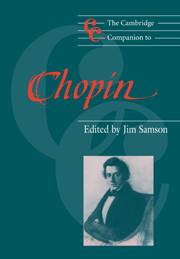Book contents
- Frontmatter
- Myth and reality: a biographical introduction
- PART 1 The growth of a style
- PART 2 Profiles of the music
- 5 Extended forms: the ballades, scherzos and fantasies
- 6 Small ‘forms’: in defence of the prelude
- 7 Beyond the dance
- 8 The sonatas
- PART 3 Reception
- Appendix A historical survey of Chopin on disc
- Notes
- List of Chopin's work
- Bibliographical note
- Index
5 - Extended forms: the ballades, scherzos and fantasies
from PART 2 - Profiles of the music
Published online by Cambridge University Press: 28 September 2011
- Frontmatter
- Myth and reality: a biographical introduction
- PART 1 The growth of a style
- PART 2 Profiles of the music
- 5 Extended forms: the ballades, scherzos and fantasies
- 6 Small ‘forms’: in defence of the prelude
- 7 Beyond the dance
- 8 The sonatas
- PART 3 Reception
- Appendix A historical survey of Chopin on disc
- Notes
- List of Chopin's work
- Bibliographical note
- Index
Summary
INTRODUCTION
It is widely recognised that Chopin's music took on new dimensions following his departure from Poland in 1830. It is recognised not least by pianists and concert promoters, who have conspicuously avoided most of the music from the Warsaw years. In some ways this is a pity since, as John Rink argues, there are works of great value from the early period and they should be assessed on their merits – as some of the highest pinnacles of post-classical popular concert music – rather than measured against the inimitable products of his full maturity. What is not in doubt, however, is the qualitative change that took place in the early 1830s. It was nothing less than a major transformation of his musical style.
That transformation, however slowly prepared, was in the end rather quickly effected and the full range of impulses underlying it are as yet only partially understood. Certainly there were biographical factors beyond the usual growth to maturity – a radical change in Chopin's self-image as Warsaw's admiration gave way to Vienna's indifference; an increasing disenchantment with the proposed career of a composer-pianist; a nostalgia for, and commitment to, his native country, sharply focussed by the Polish insurrection of 1830. Whatever the underlying causality, the result was a change not only in Chopin's musical style but in his whole approach to composition, amounting in effect to an investment in the work rather than the performance. There is too a wider context for this change in nineteenth-century concert life, as Janet Ritterman's essay in the present volume demonstrates.
- Type
- Chapter
- Information
- The Cambridge Companion to Chopin , pp. 99 - 123Publisher: Cambridge University PressPrint publication year: 1992
- 3
- Cited by

